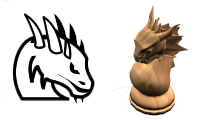
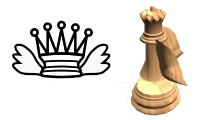
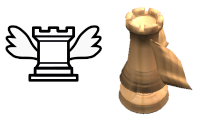
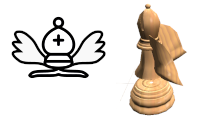
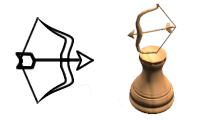
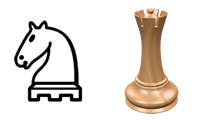
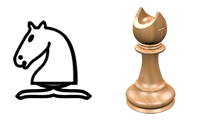
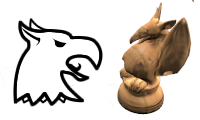
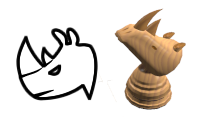
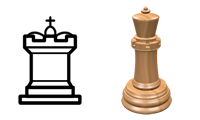
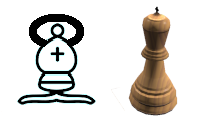
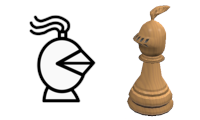
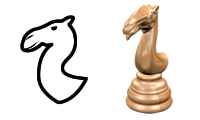

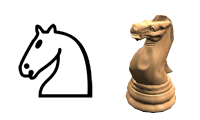

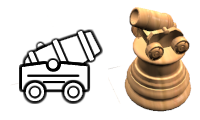

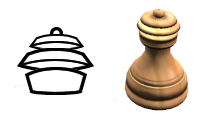
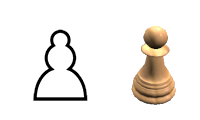

Played on a 14x14 board, with 20 fairy piece involved next to the usual King, Bishop, Rook and Queen:
 |
The Terror: moves and captures like Queen or a Knight. But can also leap directly to the second square in any diagonal or orthogonal direction. Finally it can perform hit-and-run capture on adjacent enemies, first capturing those, and then make one other King step to an empty square (but not the one it came from) in the same turn. Cannot capture a protected Terror. |
 |
The Eagle (aka Flying Queen or Great General): moves and captures like a Queen, but for capturing it can jump over arbitrary many pieces (friend or foe). The jumped-over pieces are not affected. It cannot jump over other flying pieces, (i.e. Eagle, Raven, Bat), or over an Archer, though. Cannot capture a protected Terror. |
 |
The Raven (aka Flying Rook or Rook General): moves and captures like a Rook, but for capturing it can jump over arbitrary many pieces (friend or foe). The jumped-over pieces are not affected. It cannot jump over other flying pieces, or over an Archer, though. |
 |
The Bat (aka Flying Bishop or Bishop General): moves and captures like a Bishop, but for capturing it can jump over arbitrary many pieces (friend or foe). The jumped-over pieces are not affected. It cannot jump over other flying pieces, or over an Archer, though. |
 |
The Archer: moves and captures one step orthogonally or jumps directly to the second square diagonally. Flying pieces cannot jump over it. |
 |
The Marshall: moves and captures like Knight or Rook. |
 |
The Archbishop: moves and captures like Knight or Bishop. |
 |
The Griffon: moves and captures by sliding along a trajectory that starts off by one diagonal step, and then continues outward like a Rook. |
 |
The Rhino: moves and captures by sliding along a trajectory that starts off by one orthogonal step, and then continues outward like a Bishop. |
 |
The Dragon King (aka Crowned Rook): moves and captures like King or Rook. Can castle with the King (see there). |
 |
The Dragon Horse (aka Crowned Bishop): moves and captures like King or Bishop. |
 |
The (enhanced) Champion: moves and captures to an adjacent orthogonal square, or by directly jumping to the second square diagonally or orthogonally. In addition has an 'airlift move', enabling it to slide like a Rook to where a piece (but not the board edge) in its path would block it. |
 |
The Camel (aka Long Knight): moves and captures by directly jumping to a square in the other corner of a rectangle of 2x4 squares. |
 |
The Zebra: moves and captures by directly jumping to a square in the other corner of a rectangle of 3x4 squares. |
 |
The (enhanced) Knight: moves and captures by directly jumping to a square in the other corner of a rectangle of 1x3 squares. In addition has an 'airlift move', enabling it to slide like a Bishop to where a piece standing at least four steps away (but not the board edge) in its path would block it. |
 |
The (enhanced) Elephant: moves and captures to a diagonally adjacent square or directly jumping to the second square diagonally. In addition has an 'airlift move', enabling it to slide like a Bishop to where a piece (but not the board edge) in its path would block it. |
 |
The Cannon: moves like a Rook, but can (and must) jump over one piece (friend or foe) in its path to capture. |
 |
The Diagonal Cannon (aka Vao): moves like a Bishop, but can (and must) jump over one piece (friend or foe) in its path to capture. |
 |
The Warrior: moves one or two squares straight ahead (non-jumping). Captures diagonally forward, or backward like a Knight. Its diagonal forward moves can capture Pawns or other Warriors en-passant on the squares these pass through. |
 |
The Pawn: moves and captures like an orthodox Pawn, but in its initial location it can also be pushed 3 steps forward, instead of two. Its diagonal forward moves can capture Warriors or other Pawns en-passant on the squares these pass through. |
 |
The King: moves and captures to any of the eight adjacent squares. A King that hasn't moved yet and is not in check can 'fast-castle' with a Dragon King (in the corner) that has not moved yet, by jumping directly to any empty square on the back rank in that direction, on which the Dragon King is moved to the square the King came from. |
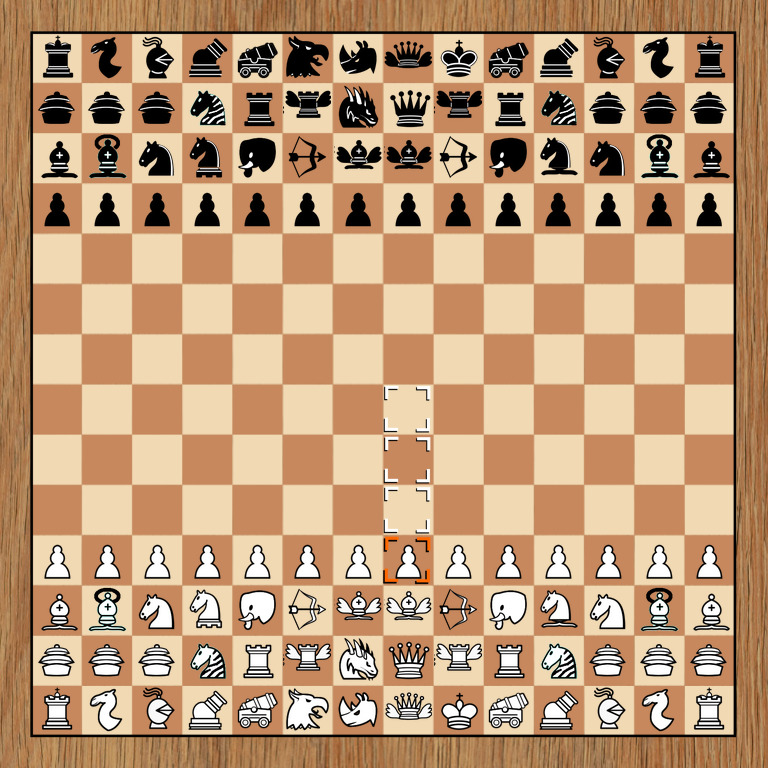
Each player starts with:
Castling: sort of. The King jumps directly to an empty square on the backrank, and the Dragon King in that direction takes its place.
Double move for Pawns (start): yes, even a triple move from their starting rank (the 4th!).
"En passant" capture: yes. To any of the squares passed through. Even Warriors can do this or fall victim to it.
Promotion: Pawns and Warriors promote on reaching the final rank, to any piece except King, Pawn, Warrior, Archer, Bat, Raven, Eagle or Terror.
Capture restrictions on Terrors: A Terror cannot be captured by a Terror or Eagle if pseudo-legal recapture would be possible on the immediately following half-move.
Threefold repetition is a draw, but it is not allowed to repeat a position through a move with an Eagle that delivers check even once.
Please see below for orthodox Chess rules.
The following text is extracted from Wikipedia, under Creative Commons Attribution-ShareAlike 3.0 License. For more details and references, please access the original article.
Chess is a game played by two people on a chessboard, with sixteen pieces (of six types) for each player. Each type of piece moves in a distinct way. The goal of the game is to checkmate, i.e. to threaten the opponent's king with inevitable capture. In addition, there are several ways that a game can end in a draw.
Chess is played on a chessboard, a square board divided into 64 squares (eight-by-eight) of alternating color, which is similar to that used in draughts (checkers). No matter what the actual colors of the board, the lighter-colored squares are called "light" or "white", and the darker-colored squares are called "dark" or "black". Sixteen "white" and sixteen "black" pieces are placed on the board at the beginning of the game. The board is placed so that a white square is in each player's near-right corner.
Each player controls sixteen pieces:
| Name | Number | White Symbols | Black Symbols |
| King | 1 |  |
 |
| Queen | 1 |  |
 |
| Rook | 2 |  |
 |
| Bishop | 2 |  |
 |
| Knight | 2 |  |
 |
| Pawn | 8 |  |
 |
At the beginning of the game, the pieces are arranged as shown in the diagram. The second row from the player contains the eight pawns; the row nearest the player contains the remaining pieces. Popular phrases used to remember the setup, often heard in beginners' clubs, are "queen on her own color" and "white on right". The latter refers to setting up the board so that the square closest to each player's right is white.
The player controlling the white army is named "White"; the player controlling the black pieces is named "Black". White moves first, then players alternate moves. Making a move is required; it is not legal to skip a move, even when having to move is detrimental. Play continues until a king is checkmated, a player resigns, or a draw is declared, as explained below. In addition, if the game is being played under a time control players who exceed their time limit lose the game.
Each chess piece has its own method of movement. Moves are made to vacant squares except when capturing an opponent's piece.
With the exception of any movement of the knight and the occasional castling maneuver, pieces cannot jump over each other. When a piece is captured (or taken), the attacking piece replaces the enemy piece on its square (en passant being the only exception). The captured piece is thus removed from the game and may not be returned to play for the remainder of the game. The king can be put in check but cannot be captured (see below).
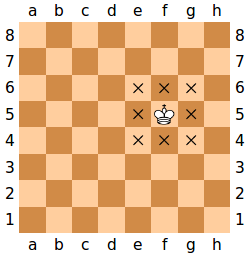
The king can move exactly one square horizontally, vertically, or diagonally. Only once per player, per game, is a king allowed to make a special move known as castling (see below).
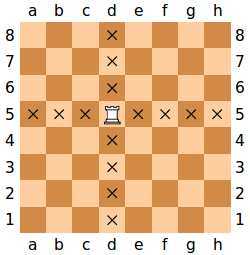
The rook moves any number of vacant squares vertically or horizontally. It also is moved while castling.
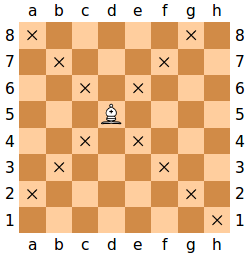
The bishop moves any number of vacant squares in any diagonal direction.
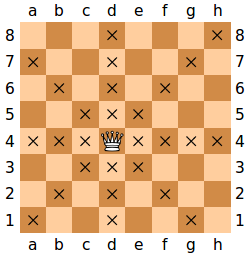
The queen can move any number of vacant squares diagonally, horizontally, or vertically.
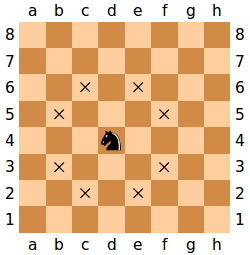
The knight moves to the nearest square not on the same rank, file, or diagonal. In other words, the knight moves two squares horizontally then one square vertically, or one square horizontally then two squares vertically. Its move is not blocked by other pieces: it jumps to the new location.
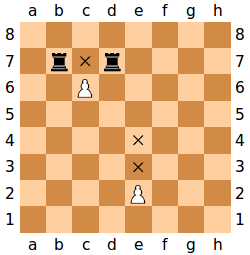
Pawns have the most complex rules of movement:
The pawn is also involved in the two special moves en passant and promotion.
Castling consists of moving the king two squares towards a rook, then placing the rook on the other side of the king, adjacent to it. Castling is only permissible if all of the following conditions hold:
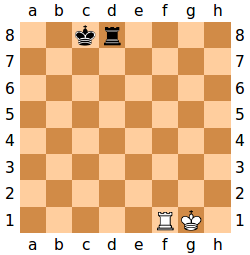
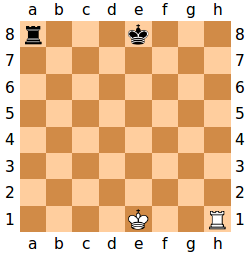
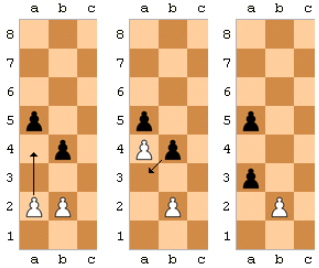
If player A's pawn moves forward two squares and player B has a pawn on its fifth rank on an adjacent file, B's pawn can capture A's pawn as if A's pawn had only moved one square. This capture can only be made on the immediately subsequent move. In this example, if the white pawn moves from a2 to a4, the black pawn on b4 can capture it en passant, ending up on a3.
If a pawn advances to its eighth rank, it is then promoted (converted) to a queen, rook, bishop, or knight of the same color, the choice being at the discretion of its player (a queen is usually chosen). The choice is not limited to previously captured pieces. Hence it is theoretically possible for a player to have up to nine queens or up to ten rooks, bishops, or knights if all of their pawns are promoted. If the desired piece is not available, the player should call the arbiter to provide the piece.

A king is in check when it is under attack by one or more enemy pieces. A piece unable to move because it would place its own king in check (it is pinned against its own king) may still deliver check to the opposing player.
A player may not make any move which places or leaves his king in check. The possible ways to get out of check are:
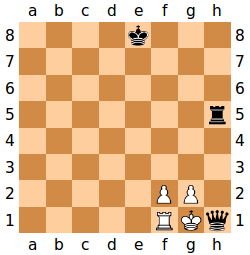
If a player's king is placed in check and there is no legal move that player can make to escape check, then the king is said to be checkmated, the game ends, and that player loses. Unlike other pieces, the king is never actually captured or removed from the board because checkmate ends the game.
The diagram shows a typical checkmate position. The white king is threatened by the black queen; every square to which the king could move is also threatened; it cannot capture the queen, because it would then be threatened by the rook.

The game ends in a draw if any of these conditions occur:
The game is immediately drawn when there is no possibility of checkmate for either side with any series of legal moves. This draw is often due to insufficient material, including the endgames
The player having the move may claim a draw by declaring that one of the following conditions exists, or by declaring an intention to make a move which will bring about one of these conditions:
If the claim is proven true, the game is drawn.
At one time, if a player was able to check the opposing king continually (perpetual check) and the player indicated their intention to do so, the game was drawn. This rule is no longer in effect; however, players will usually agree to a draw in such a situation, since either the rule on threefold repetition or the fifty-move rule will eventually be applicable.